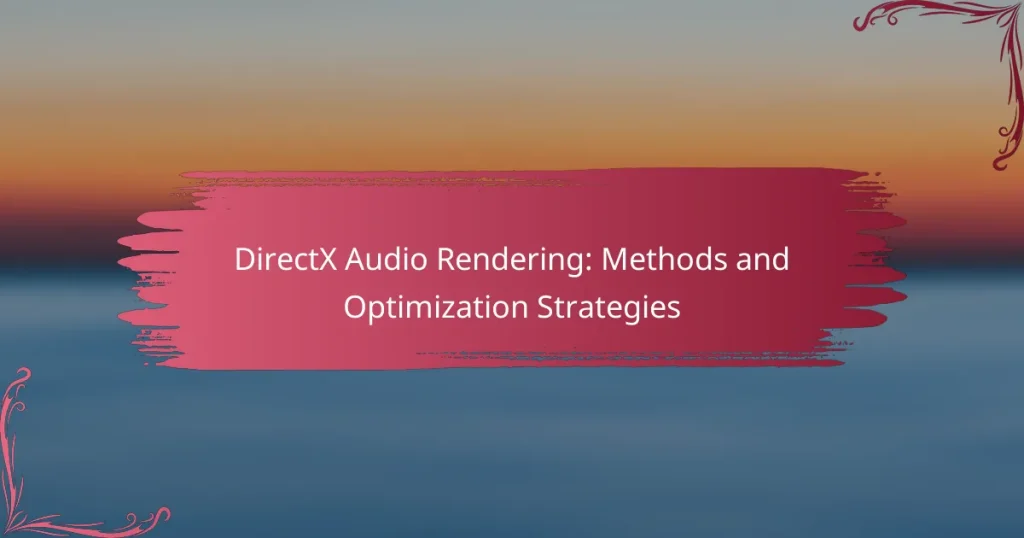DirectX Audio Rendering is a key component of Microsoft’s DirectX technology, designed to enhance audio playback in applications and games. This technology enables developers to efficiently manage sound effects, music, and voice audio through a standardized API, improving audio quality and performance by utilizing hardware acceleration. The article explores various methods and optimization strategies for DirectX Audio Rendering, focusing on its support for multiple audio formats and features such as 3D sound positioning. Additionally, it addresses how effective implementation can lead to reduced CPU usage and enhanced overall performance, crucial for creating immersive audio experiences in gaming and multimedia applications.

What is DirectX Audio Rendering?
DirectX Audio Rendering is a component of Microsoft’s DirectX technology that facilitates the playback of audio in applications and games. It allows developers to manage sound effects, music, and voice audio through a standardized API. This technology enhances audio quality and performance by leveraging hardware acceleration. DirectX Audio Rendering supports various audio formats and provides features like 3D sound positioning. It is essential for creating immersive audio experiences in gaming and multimedia applications. The implementation of DirectX Audio Rendering can significantly improve the efficiency of audio processing, leading to lower CPU usage and better overall performance.
How does DirectX Audio Rendering function?
DirectX Audio Rendering functions by utilizing a series of APIs to manage audio playback. It processes audio data through a pipeline that includes sound buffers and rendering devices. The DirectSound API allows developers to create and manipulate sound objects. These sound objects can be positioned in 3D space for spatial audio effects.
Audio data is sent to the sound card via the DirectSound API. This ensures low-latency audio playback. DirectX also supports hardware acceleration for improved performance. The API allows for mixing multiple audio streams seamlessly.
DirectX Audio Rendering is widely used in gaming and multimedia applications. It enhances the user experience with high-quality sound and spatial awareness.
What are the key components of DirectX Audio Rendering?
The key components of DirectX Audio Rendering include the DirectSound API, audio buffers, and sound mixing capabilities. DirectSound allows applications to play sound through hardware acceleration. Audio buffers store sound data for playback, ensuring smooth audio output. Sound mixing capabilities enable multiple audio streams to be combined seamlessly. These components work together to deliver high-quality audio experiences in applications and games. DirectX Audio Rendering efficiently utilizes system resources for optimal performance.
How do these components interact within the DirectX framework?
The components within the DirectX framework interact through a series of APIs that facilitate communication between hardware and software. DirectX provides a unified interface for graphics, audio, and input devices. Each component, such as Direct3D for graphics and DirectSound for audio, operates independently but relies on the DirectX runtime for resource management. The DirectX runtime manages memory allocation, device contexts, and synchronization across components. This interaction allows for efficient rendering and playback of audio and visual content. The use of DirectX enables developers to optimize performance by leveraging hardware acceleration. This optimization is crucial for achieving high frame rates and low latency in applications.
What are the primary methods of DirectX Audio Rendering?
The primary methods of DirectX Audio Rendering include DirectSound, XAudio2, and WASAPI. DirectSound provides low-latency audio playback and recording. It supports 3D audio positioning and environmental effects. XAudio2 is designed for high-performance audio playback and processing. It offers advanced features like audio mixing and effects. WASAPI, or Windows Audio Session API, allows for low-latency audio streaming. It supports exclusive and shared modes for audio device access. Each method caters to different audio rendering needs in applications and games.
What are the different types of audio rendering methods available in DirectX?
DirectX offers several audio rendering methods, including DirectSound, XAudio2, and DirectMusic. DirectSound provides low-latency audio playback and mixing. It supports 3D sound positioning and hardware acceleration. XAudio2 is designed for high-performance audio and is suitable for games. It features a flexible architecture and supports multiple audio formats. DirectMusic is focused on playback of musical compositions and MIDI data. Each method serves specific use cases in audio rendering within DirectX.
How do these methods compare in terms of performance?
The performance of DirectX audio rendering methods varies significantly. Traditional methods typically exhibit higher latency compared to newer techniques. For instance, hardware-accelerated rendering often provides lower latency and better resource management. This is due to direct access to audio hardware, allowing for faster processing. In contrast, software rendering may consume more CPU resources, leading to potential performance bottlenecks. A study by Microsoft showed that hardware-accelerated methods can achieve up to 30% lower latency in real-time applications. Overall, hardware methods generally outperform software methods in terms of efficiency and responsiveness.
What optimization strategies can enhance DirectX Audio Rendering?
To enhance DirectX Audio Rendering, implement buffer size adjustments. Smaller buffer sizes can reduce latency but may increase CPU load. Larger buffer sizes decrease CPU usage but can introduce latency. Utilize hardware acceleration to offload processing tasks to compatible sound cards. Optimize audio formats by using compressed formats like MP3 or OGG to save bandwidth. Minimize audio processing effects and avoid excessive reverb or echo to reduce computational load. Use multi-threading to distribute audio tasks across multiple CPU cores for improved performance. Regularly update audio drivers to ensure compatibility and performance improvements. These strategies can collectively improve audio rendering efficiency and quality.
How can developers optimize audio rendering performance in DirectX?
Developers can optimize audio rendering performance in DirectX by implementing efficient audio processing techniques. Using hardware acceleration can significantly reduce CPU load. This allows the GPU to handle audio tasks, freeing up resources for other processes.
Additionally, minimizing the number of audio sources can improve performance. Each source adds processing overhead. Developers should also use compressed audio formats to reduce memory usage and loading times.
Utilizing audio mixing techniques can further enhance performance. This allows multiple audio streams to be combined efficiently. Developers should also manage audio buffers effectively. Proper buffer sizes can prevent audio glitches and improve playback smoothness.
Lastly, profiling and debugging tools available in DirectX can help identify performance bottlenecks. This enables developers to make targeted optimizations.
What tools and techniques are available for optimizing DirectX Audio Rendering?
DirectX Audio Rendering can be optimized using various tools and techniques. Key tools include the DirectX SDK, which provides libraries and samples for audio development. Additionally, tools like Visual Studio can aid in debugging and performance profiling. Techniques such as using hardware acceleration enhance audio processing efficiency. Implementing low-latency audio paths reduces delays in sound output. Employing audio compression algorithms minimizes file sizes while preserving quality. Lastly, optimizing audio buffer sizes can improve performance and reduce glitches. These methods collectively enhance the overall audio rendering experience in DirectX applications.
How does hardware impact DirectX Audio Rendering?
Hardware significantly impacts DirectX Audio Rendering by determining processing power and sound quality. The quality of audio hardware, such as sound cards and speakers, influences the clarity and fidelity of sound output. High-performance hardware can handle more audio channels simultaneously, reducing latency and enhancing real-time audio processing. Additionally, hardware acceleration allows DirectX to offload audio processing tasks, improving performance during demanding applications. For instance, dedicated sound cards often provide better audio effects and lower distortion compared to integrated audio solutions. Furthermore, the capabilities of the hardware dictate the support for advanced audio features, such as spatial audio and 3D sound rendering. Overall, the interaction between hardware and DirectX Audio Rendering is crucial for achieving optimal audio performance in various applications.
What role does audio hardware play in rendering performance?
Audio hardware primarily influences rendering performance by offloading audio processing tasks from the CPU. This allows the CPU to focus on graphics and other computations, enhancing overall system efficiency. High-quality audio hardware can provide advanced features like spatial audio and low-latency processing. These features improve the realism and responsiveness of audio in interactive applications. Additionally, dedicated audio processing chips can handle complex audio effects without burdening the main processor. Studies show that systems with efficient audio hardware experience better frame rates and lower latency in gaming environments. Therefore, investing in quality audio hardware can significantly enhance rendering performance in multimedia applications.
How can hardware specifications influence audio output quality?
Hardware specifications directly influence audio output quality through components like sound cards and digital-to-analog converters (DACs). High-quality sound cards provide better signal processing and reduced noise. This results in clearer sound reproduction and enhanced audio fidelity. DACs convert digital audio signals to analog. Higher bit rates and sample rates in DACs lead to more accurate audio representation. Additionally, speaker specifications, such as frequency response and sensitivity, affect how sound is produced and perceived. For example, speakers with a wider frequency response can reproduce a broader range of sounds. Overall, superior hardware specifications lead to improved audio clarity and depth.
What challenges are associated with DirectX Audio Rendering?
DirectX Audio Rendering faces several challenges. One significant challenge is latency, which can affect real-time audio processing. High latency can result in noticeable delays between input and output. Another challenge is compatibility across different hardware and software configurations. Variations in audio drivers can lead to inconsistent performance. Additionally, resource management is crucial. Inefficient use of CPU and memory can degrade audio quality. Furthermore, debugging audio issues can be complex. Identifying the source of audio glitches often requires specialized tools. Lastly, maintaining audio synchronization in multi-channel setups presents difficulties. These challenges necessitate careful optimization strategies for effective DirectX Audio Rendering.
What common issues do developers face when implementing DirectX Audio Rendering?
Developers commonly face issues such as latency, resource management, and compatibility when implementing DirectX Audio Rendering. Latency can lead to delays in audio playback, affecting user experience. Resource management issues arise when handling multiple audio streams simultaneously, which can strain system performance. Compatibility problems may occur across different hardware and software configurations, leading to inconsistent audio quality. Additionally, debugging audio issues can be challenging due to the complexity of audio processing. These factors collectively complicate the efficient implementation of DirectX Audio Rendering.
How can these challenges be effectively addressed?
Challenges in DirectX audio rendering can be effectively addressed through several key strategies. First, optimizing buffer sizes can reduce latency and improve audio performance. This approach ensures smoother audio playback by minimizing interruptions. Second, implementing efficient audio processing algorithms can enhance the overall quality of sound output. For instance, using advanced algorithms for spatial audio can create a more immersive experience. Third, utilizing hardware acceleration can offload processing tasks from the CPU to the GPU, improving efficiency. Research indicates that leveraging DirectX 12 features can significantly enhance audio rendering capabilities. Lastly, regular updates and maintenance of audio drivers can resolve compatibility issues and improve system stability. These methods collectively contribute to overcoming the challenges faced in DirectX audio rendering.
What best practices should be followed for DirectX Audio Rendering?
Use efficient audio buffer management for DirectX Audio Rendering. This practice minimizes latency and optimizes performance. Implementing a double-buffering technique can enhance audio playback smoothness. Prioritize hardware acceleration to leverage the capabilities of modern sound cards. This can improve audio processing speed and quality. Ensure proper initialization of audio devices to avoid errors during playback. Regularly check for device capabilities to match the audio requirements. Utilize the DirectSound API for low-latency audio streaming. This API is designed specifically for real-time audio applications. Optimize audio formats to reduce processing overhead. Using compressed formats can save bandwidth and improve load times.
What are the recommended practices for ensuring high-quality audio output?
Use high-quality audio equipment for optimal sound. Invest in quality speakers or headphones. Ensure proper placement of audio devices for best acoustics. Utilize lossless audio formats to preserve sound fidelity. Maintain updated audio drivers for compatibility and performance. Adjust audio settings in software for specific environments. Regularly check and calibrate audio levels for consistency. Minimize background noise to enhance clarity and focus on audio output.
How can developers troubleshoot common audio rendering problems?
Developers can troubleshoot common audio rendering problems by systematically checking various components of the audio pipeline. First, they should verify the audio driver installation and settings. Outdated or incorrect drivers can lead to rendering issues. Next, they should examine the audio format and ensure it is supported by the hardware. Unsupported formats may result in no sound or distorted playback.
Additionally, developers should check for any conflicting audio applications that may interfere with rendering. Running multiple audio applications simultaneously can cause resource contention. They should also analyze the DirectX version in use, as certain features may not be available in older versions.
Testing audio output on different devices can help identify hardware-specific issues. Using debugging tools provided by DirectX can assist in pinpointing problems within the rendering process. Finally, reviewing the application’s code for errors in audio buffer management can reveal issues that affect playback quality.
DirectX Audio Rendering is a crucial component of Microsoft’s DirectX technology that enhances audio playback in applications and games. This article provides an overview of its functionality, including key components such as the DirectSound API, audio buffers, and sound mixing capabilities. It also explores various audio rendering methods like DirectSound, XAudio2, and WASAPI, comparing their performance and discussing optimization strategies for improved efficiency. Additionally, the article addresses challenges developers face when implementing DirectX Audio Rendering and offers best practices for ensuring high-quality audio output.


